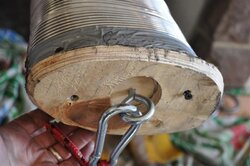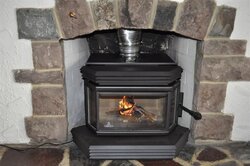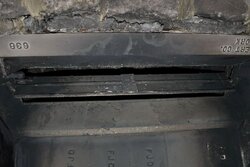M
mhrischuk
Guest
I haven't found a clear post on what people do at the damper when running a flex liner.
One fellow told me he removes the damper control then he takes a sawzall and cuts out the mortered-in frame only in the center area to make enough room for the liner to fit.
I also have been reading about ovalizing the liner and oval to round adapters.
Is there a preferred method?
I perceive it as this....
1) Measure the width of the damper opening.
2) Determine the amount of "squeeze" required to get the liner through the damper frame.
3) If it's too much (how much is too much) then the frame needs to be hacked away?
4) If it looks feasible, oval the liner as far back as required, drop the liner down the chimney and feed it through the damper frame.
Once the chimney top has been finalized, cut the stove end of the liner to length taking into account the liner to stove adapter.
by hand, squeeze the end of the liner back to round and attach the adapter.
What does an oval to round adapter look like and is it ever necessary?
On edit.... I did find a topic here https://www.hearth.com/econtent/index.php/forums/viewthread/42839/
Also this one. This is exactly the damper I have. https://www.hearth.com/econtent/index.php/forums/viewthread/42037/
I guess the big question is, if there are no negatives to ovalizing the liner, why do installers so often destroy a perfectly good fireplace damper install when they only have to crush the liner some? Is this the so-called "professional" method?
One fellow told me he removes the damper control then he takes a sawzall and cuts out the mortered-in frame only in the center area to make enough room for the liner to fit.
I also have been reading about ovalizing the liner and oval to round adapters.
Is there a preferred method?
I perceive it as this....
1) Measure the width of the damper opening.
2) Determine the amount of "squeeze" required to get the liner through the damper frame.
3) If it's too much (how much is too much) then the frame needs to be hacked away?
4) If it looks feasible, oval the liner as far back as required, drop the liner down the chimney and feed it through the damper frame.
Once the chimney top has been finalized, cut the stove end of the liner to length taking into account the liner to stove adapter.
by hand, squeeze the end of the liner back to round and attach the adapter.
What does an oval to round adapter look like and is it ever necessary?
On edit.... I did find a topic here https://www.hearth.com/econtent/index.php/forums/viewthread/42839/
Also this one. This is exactly the damper I have. https://www.hearth.com/econtent/index.php/forums/viewthread/42037/
I guess the big question is, if there are no negatives to ovalizing the liner, why do installers so often destroy a perfectly good fireplace damper install when they only have to crush the liner some? Is this the so-called "professional" method?




